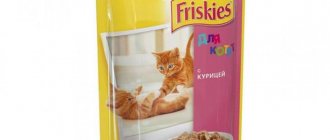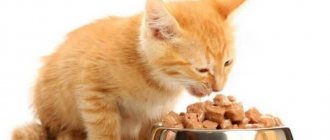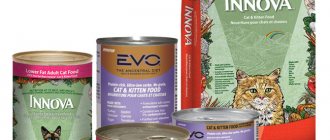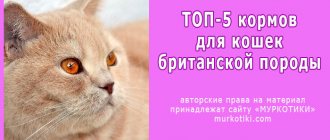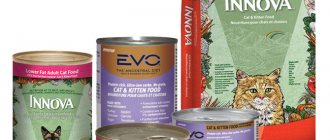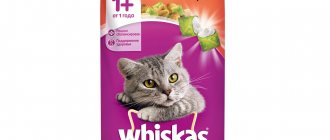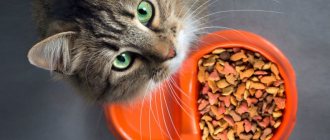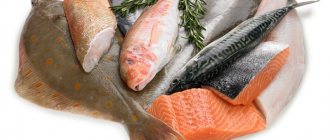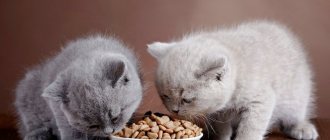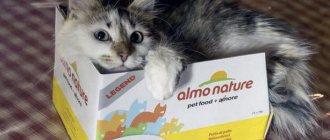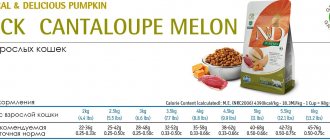The health of pets largely depends on their diet. Today, most of them eat industrial powdered formula. And in order to choose the right food for your cat, you need to be able to decipher its composition. Let’s say right away that you shouldn’t buy economy class food, they contain a lot of ingredients and flavorings that are harmful to animals, it is better to give preference to premium and super premium classes.
History of appearance
Prepared animal feed began to be produced in the 1860s. English electrician James Spratt invented the “dog biscuit”, which included beef blood, wheat and vegetables. These were the first crackers for pets; soon many businessmen picked up the idea and began producing similar products. In the 1890s, know-how migrated to the USA.
At the beginning of the 20th century, prepared pet foods became popular; the first canned food for cats was released in the 30s by Gaines Food.
In the 1940s, dry food also appeared. Since the metal was used to meet the needs of the front, canned food for animals was not produced. But the producers did not want to give up their profitable business, and therefore switched to dry products.
At that time, there were two types: granules (sold ready-made) and balls (they had to be kneaded by hand).
After the war, people's well-being improved, and they could already afford to purchase food for four-legged animals. Many companies have added this position to their product manufacturing. These were Mars, Lipton, Quaker Oats, Post, Carnation, etc. Most canned foods back then were fish.
A new milestone in the history of animal feed was the introduction of new technology in the 50s by Purina. This was using extrusion, a process of preparing feed by pushing it through an extruder. As a result of this treatment, the finished product seemed to be swollen, increased in volume, after which it was baked. Manufacturers used the new technology as a marketing ploy, offering more food for the same money, but the benefits of such products were questionable. Firstly, the crackers were sprinkled with flavorings, and secondly, a large amount of starch was added to the extrusion mixture - mostly corn.
Later, manufacturers contributed to an active educational campaign for pet owners, promoting the harmfulness of food from the owners’ tables for cats, thereby trying to increase sales of their products.
Is Kitekat harmful for cats: the opinion of veterinarians, animal owners, the manufacturer
Reviews about this food are contradictory. According to veterinarians, this product should not be in your pet’s diet. At the same time, they note that nothing bad will happen to a cat from using “Kitiket” once. However, constantly feeding your four-legged pet this food can result in serious problems with its health.
Buying economy-class ready-made cat products is similar to choosing food for people. If a person does not have the opportunity to buy quality meat, he buys inexpensive sausages or sausages. At the same time, he understands that they contain many chemical components and are unlikely to benefit his body. The same goes for cat food. Each cat owner buys food for it based on their financial capabilities.
If it is not possible to purchase high-quality food for your four-legged pet, veterinarians recommend following the following rules when feeding your pet cheap food:
- do not mix natural and prepared food;
- feed the animal with products of different forms of release of only one brand;
- When feeding your cat dry food, make sure that he drinks a lot of water;
- do not use vitamins without the consent of your veterinarian;
- follow the manufacturer's recommendations regarding the amount of feed and frequency of feeding;
- Feed pregnant and lactating pets more often, avoiding starvation.
Cat owners are divided into 2 camps regarding the harm of this food to the health of their pets. Opponents of cheap ready-made cat food consider it real poison. Its supporters are confident that if economy-class food is permitted by law and has certificates, it means that it has been tested for all safety and quality parameters and is not capable of causing harm. They believe that the main source of animal health problems is not the available food, but the owners of these pets themselves, who do not comply with the rules for using economy-class products.
, which is quite natural, does not consider its product harmful. He claims that his product is an ideal source of vitality for cats, as it contains all the necessary nutritional supplements and vitamins.
If you believe the advertising, “Kitekat” helps maintain muscle tone, strength and activity of the animal, strengthens its bones and teeth, gives the skin a healthy look and coat a magnificent shine, helps improve vision and stable heart function, strengthens the immune system and improves metabolic processes in the body .
In our time
Over the course of a century and a half, industrial animal feed has undergone significant changes, but not all owners are inclined to trust ready-made diets, doubting the quality of the original products. Therefore, owners continue to feed cats “human” food. Is this acceptable? And what is better for four-legged pets - ready-made food or natural products? This issue needs to be carefully looked into so as not to risk the health of our little brothers. To understand whether prepared foods are healthy, you need to understand what they are actually made from.
When choosing a product to feed your pet, it is important to analyze the composition of the first one by carefully reading the labels on the packaging. What is dry cat food made from?
Meat
The main ingredients in the composition are components of animal origin. These include not only meat itself, but also offal, fish and eggs. It is a source of protein for four-legged animals. The cat's body best absorbs amino acids from poultry, as well as fish, lamb and beef. This does not mean that the animal should not be given other types of meat food. If there are no allergies and the food is well digested, it is worth diversifying the menu by offering different types of crackers.
On the food package this ingredient may be written under the word “Meat”. This also includes animal muscle tissue, which may include fat, tendons, blood vessels, and skin. The “meat” is subjected to mechanical deboning, grinding into minced meat. The poultry and fish in the composition are usually isolated; they cannot be called “meat”. What else goes into ready-made animal food?
Instead of meat
What else is included in cat food?
- Meat by-products. These are the remaining edible parts of mammals, for example, liver, kidneys, tripe. There may also be lungs and udders, although they are not edible for humans, animals can eat them.
- Bird. This refers to all edible parts of birds, except feathers, entrails, heads and legs. This also includes bones and skin. They are ground together with the pulp, and the bones are also a valuable source of calcium. The manufacturer often indicates the type of poultry - chicken, turkey.
- Poultry by-products. This includes heads, legs and intestines, as well as the heart, liver and stomach.
What is cat food made from? Inexpensive products called “Meat” and “Poultry” use by-products at best.
How it all began
Cats have been living with humans for quite a long time. Friendship began when people began to grow cereal crops and store grain in barns. The cats, still wild at that time, probably thought it was very nice of people to put so much bait for rodents in one place. And they did not miss the opportunity to hunt them right next to people.
The cats received an amazing food supply. People received reliable protection of supplies from rodents. Good for both.
And throughout most of the history of relationships between humans and cats, our furry friends ate what they could catch and what humans gave them: scraps and scraps. The cats thrived and thrived on this diet of mostly fresh meat. And they practically did not know those diseases that are so common these days.
This idyll lasted until the middle of the 19th century.
Flour
Flour or hydrolyzed product. What is found under this name in animal feed? During the processing process, moisture, fat, bacteria, and microorganisms are removed from the components under the influence of high temperature and pressure. Only proteins and minerals remain, they are ground to powder. The resulting powder is called “flour” or “hydrolyzed” product.
- Meat meal is a powder obtained from the processing of mammalian tissue, and not only muscle tissue. Thus, meat flour can be produced not only from meat, but also from offal. Mammals may be different; the manufacturer may indicate their species, but this is not necessary.
- Meat and bone meal. Almost the same as meat meal, but it also contains crushed bones. The manufacturer indicates the amount of minerals and nutrients, but does not have to indicate from whom the flour was obtained.
- Flour from animal by-products. It is obtained from meat, bones and offal. The starting raw material can be whole mammal carcasses.
- Poultry by-product meal. This component is obtained from whole poultry carcasses or their by-products. The raw materials are crushed and processed to remove moisture and fat. The result is a protein-mineral ingredient.
- Poultry meal. It is obtained by processing an ingredient called "Poultry". What is cat food made from and what else is present in its composition?
What to look for when choosing cat food
When you go to a pet store for the first time, it’s not surprising to be overwhelmed by the huge variety of cat food on offer. But in order to make the right choice, you still need to have a cool head on your shoulders and, when choosing food for your family pet, focus not only on beautiful packaging and reasonable cost, but also on analyzing cat food on the following points!
- If you don’t yet understand food brands, then pay attention to the country of origin. By all accounts, the best food is made in Denmark, Germany, Canada, the USA and the UK.
- Advanced cat owners need to pay attention to the brand of food. The reputation of some foods is very tarnished, while others, on the contrary, are undeservedly deprived of the attention of buyers. You can learn more about this in the article rating dry cat food.
- But the most important thing in any food is the composition. We will teach you how to read, analyze and compare cat food and instantly assess its real benefits or harm.
Vitamins and minerals
The processed raw materials from which cat food is produced are a source of proteins and carbohydrates. Vitamins and minerals are not preserved after processing, so they are added artificially. The manufacturer describes them:
- by simple enumeration - copper, iron, sodium, zinc, calcium;
- indicating specific substances containing minerals.
The sources of minerals are synthetic additives: iron amino acid complex, zinc polysaccharide complex. It is believed that minerals are better absorbed from such compounds.
Vitamins are also added in the form of artificial substances: cholecalciferol (vitamin D from animal sources), ergocalciferol (vitamin D from plants), riboflavin (vitamin B2), vitamin A, vitamin E, thiamine mononitrate (source of vitamin B1), vitamin B6.
So, behind complex chemical names are hidden artificial analogues of natural components that disappeared from the feed during processing. Amino acids (DL-methionine, L-lysine, DL-tryptophan) are also replaced.
But that is not all
What is a piece of fresh meat? - A piece of fresh meat. What happens if the meat is dried and crushed into powder, mixed with vegetable powder, mineral powder and vitamin powder? You will get a powder.
In order to make “soft pieces” or “crispy crackers” from powder, new additives are needed: thickeners and emulsifiers. For example, carrageenan or carrageenan (E-407) is a natural thickener obtained from red seaweed. Or its analogue - agar-agar (E-406). Or guar gum (E412) – extract of guar (pea tree) seeds. In order for the food, consisting of ingredients ground into flour, to have a tasty (for the cat) smell, flavorings are needed: extracts of ginger, chamomile, fennel, rosemary, etc.
To prevent concentrated cat food from becoming a source of cholesterol, as well as to reduce the risk of cardiovascular diseases, components that bind bile acids are needed - sequestrants or statins.
Preservatives
Of course, any feed contains substances that ensure long-term storage of the product. Possible preservatives include:
- ascorbic acid;
- benzoic acid,
- butylated hydroxyl anisole (BHA),
- butylated hydroxyl toluene (BHT),
- calcium ascorbate,
- lemon acid,
- ethoxyquin,
- potassium sorbate,
- sodium bisulfate,
- tocopherols.
It is the manufacturer's responsibility to indicate the preservative used.
How to distinguish quality food?
Meat should be first on the ingredient list. The preferred by-products are kidneys, heart, stomach, liver, and lungs. Tripe and chicken heads are acceptable in small quantities. Such components are included in super-premium and holistic food categories.
General names such as “Meat”, “Poultry”, “Offal” are not desirable. Under these names, various ingredients may be used, and of questionable quality. If the manufacturer avoids specifics, perhaps he wants to hide something from the consumer.
Extracts instead of the substances themselves in the feed are undesirable. For example, instead of meat, hydrolyzed animal proteins may be included. Often the share of meat ingredients can be no more than 4%, as happens in economy-class feeds. This is very little for predators, and therefore such products are not useful for pets.
Below is a comparison of cat food composition.
Cellulose
Fiber is the hard shell of a plant cell, which is not digested in the body, but improves intestinal motility and serves as a breeding ground for the proliferation of friendly microflora. Beetroot is most often used as a source of fiber in feed, but this is not the same table beet that we add to borscht or vinaigrette. We are talking about sugar beet pulp remaining after sugar production; on the label this product is indicated as beet pulp.
Actually, there is practically no sugar left in the pulp, but it contains a lot of fiber, which improves the functioning of the gastrointestinal tract. Many manufacturers add a variety of vegetables and fruits to their products, and they can also serve as an additional source of fiber, although beet pulp is in no way inferior to them in its properties.
Royal Canin Adult British Shorthair
Belongs to the premium class. Royal Canin dry cat food contains plant protein isolate and dehydrated animal proteins (poultry), as well as hydrolyzed animal proteins and a natural flavor additive. In addition, rice, wheat and cereal flour act as carbohydrates. The fats used are animal oil, fish oil and soybean oil. The fiber used is vegetable. There is a mineral supplement, yeast, fructooligosaccharides.
Royal Canin cat food comes in a wide range of flavors and contains a large amount of vitamins and minerals. However, the price of the goods is not low.
"Felix" (in bags)
What is this brand of cat food made from? This is economy food. It contains meat and its processed products (4% chicken, 4% lamb). However, what kind of meat is included and how much of it is unknown. In addition, there is a vegetable protein extract, fish and its products, minerals, dyes, sugars, and vitamins. The advantages are considered to be affordable price and widespread availability. The disadvantages are that Felix cat food contains unknown components in unclear quantities.
"Whiskas"
Economy class product. What is Whiskas cat food made from? Its production uses chicken, fish meal, turkey, corn, rice, animal fat, vitamins and minerals, preservatives and flavorings.
Disadvantages of this brand of food:
- Whiskas cat food contains many ingredients of dubious quality, indicated by general formulations.
- A large number of plant components.
- It is unclear what flavorings and preservatives are contained.
- High percentage of potential allergens (corn, caramel).
Other Ingredients
Animal and vegetable fats and oils are used to give food an attractive taste and increase its energy value. Plant ingredients such as corn, barley, rice, peas or potatoes serve primarily to bind the ingredients into pieces and crackers, and then as a source of carbohydrates. Other sources of carbohydrates can be dried beet pulp and chicory root, cellulose powder and so-called “complex carbohydrates” - fructose-based polysaccharides extracted from plant roots (inulin, fructooligosaccharide).
Acana Grasslands for Cats
The food belongs to the holistic class. It contains lamb, lamb liver, lamb flour, salmon, eggs, lentils, herring flour, lamb and duck fat, apples, carrots, cranberries, pumpkin, peas, vitamins and minerals, dandelion, chamomile, mint.
The food is characterized by a high meat content, the presence of preventive additives, duck, fish and lamb fats.
So, having figured out what cat food is made from, we now understand that if you choose this option for feeding your cat, you should purchase high-quality products, since they contain components beneficial to the health of the animal.
